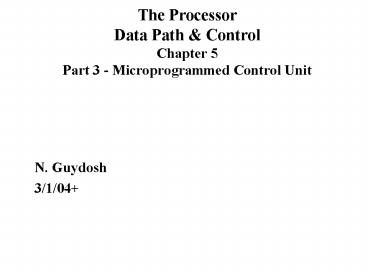The Processor Data Path PowerPoint PPT Presentation
1 / 10
Title: The Processor Data Path
1
The ProcessorData Path ControlChapter 5Part
3 - Microprogrammed Control Unit
- N. Guydosh
- 3/1/04
2
Tradeoffs
- Tradeoffs between hardware vs microprogrammed
controller - Advantages Of MicroprogrammedUsually Easier To
Document And UnderstandMore Flexible Easier,
Faster, And Cheaper To Fix Design bugs - Disadvantages Of Microprogrammed
- May Be Slower Than Direct Hardware Implementation
- May Involve More Support People Team Of
"Microcoders" More Managers Needed
3
Microprogrammed controller
- Control lines directly generated (asserted) by
microinstructions as they get executed by a
data path - Data path for microinstructions is distinct from
the data path of the main architecture (MIPS)
instructions - An embedded computer within a computer
- The microprogrammed controller computer is
generally special purpose - micro-data pathTypically has only an
instruction memory implemented as rom or flash
memory rather than a ram has minimal computation
capability - Microinstructions Main goal in life is to
generate control signals - orExecute (interpret) architecture instructions
4
Microprogramms
- Two basic categories of microprogramming
horizontal vs vertical (see p. C-31 ) - Vertical
- Shorter word
- More decoding needed to interpret fields
(maximal encoding) - Words are more functional
- Micro data hardware path more complicated
- Ex older IBM main frames (s360/s3670)used it
- Horizontal (used here)
- Longer word
- Direct relationship between fields/word bits and
control signals - Minimal encoding of fields - may have a bit
significant relationship between word bits and
control signals. - Micro data hardware path simpler
- ExPowerPCs employed horizontal code
5
Microinstructions
- Relationship to FSM
- A state in the FSM usually corresponds to the
execution of a microinstruction - Sequencing of microinstructions
- Next microinstruction to execute may be
sequential, a conditional branch, or an
unconditional branch - Flow pattern follows the flow of the state
diagram - sequential within a routine
- conditional branch based on opcode (and status)
to various "subroutines" - unconditional branch usually at the end of a
cycle transferring control to the fetch
routine - default is sequential
- instruction carries a next address field. ...
Compare to assembly language instructions
6
Defining The Microinstruction
- Microinstruction is made up of a series of fields
corresponding each corresponding to related
groups of control signals and a sequencing
field - Criteria for choosing fields
- must encompass all control signals
- Must be consistent don't make "overlapping fields
require that a control signal be both asserted
de-asserted. - use control signals defined on p. 384, fig. 5.34
for defining fields. ... See also p. 383, fig.
5.33 for big picture previous slides
7
Defining The Microinstruction
Note MDR benignly written by default
, IRWrite
Note IRWrite added above, now 18 control lines.
8
The Microprogram
Number of control lines
2 1 2
3 4
4 2 gt 18
total
Note Read PC includes IRWrite corresponding to
fix in Fig. C21.
9
Dispatch Tables
The Microcode assembler uses the encoding of the
sequence field in the microword the contents of
the above dispatch tables the specification
(field gt control lines) of fig
C21 microprogram itself To generate the
microinstructions to execute If the sequence
field is a dispatch specification selecting one
of the tables above, then the opcode is used to
access within one of the above tables.
10
Implementation
1 1 1 1 1 1 1 2 2 2 1 1 1
The control lines activated are the actual bits
of the mico-word selected. horizontal
microcode
? typo see below
2
Note for those with earlier printing of
bookBWrite doesnt seem to get used
anywhere. B register is unconditionally
written. If BWrite is dropped, we have the
correct number control lines (18).

